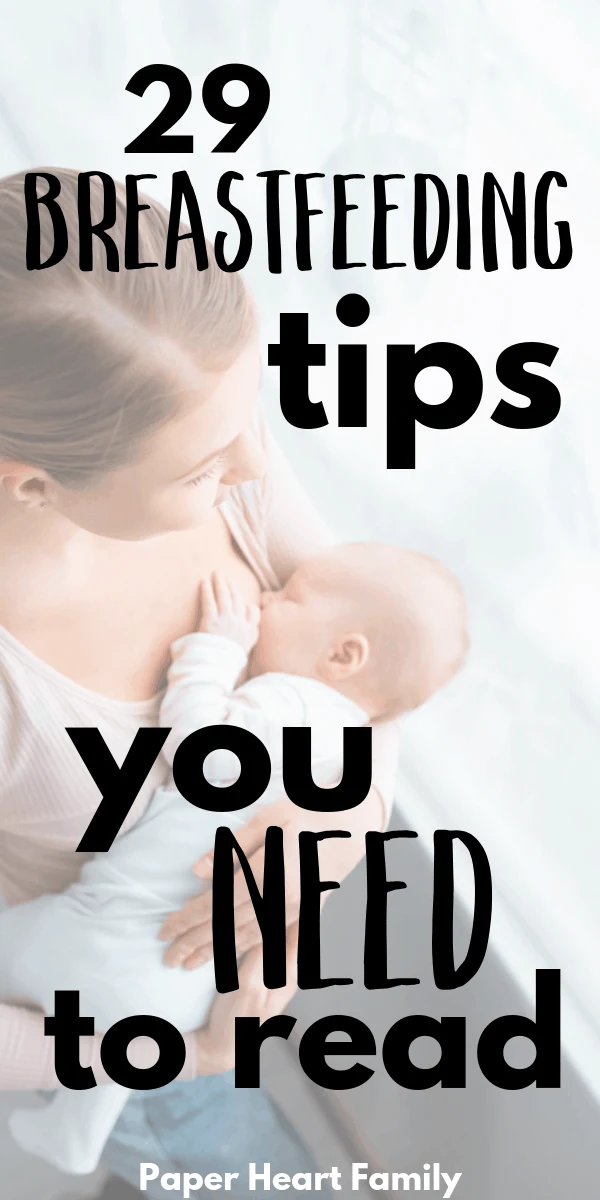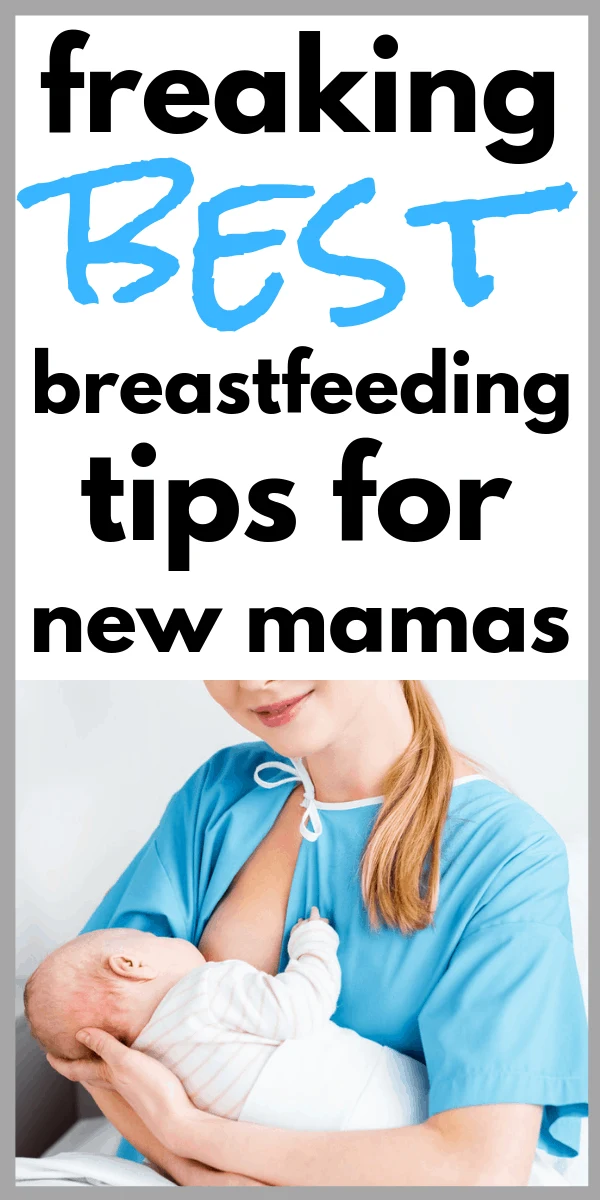I wanted to write this post on breastfeeding tips for new mothers because I believe in order to be successful and get through those first difficult weeks, you NEED to be educated. You need to be encouraged and informed because breastfeeding is HARD.
Hard.What? I thought breastfeeding was natural.
While breastfeeding is natural, meaning something that nature intended, it definitely doesn’t FEEL natural at first.
Four in 10 breastfeeding mothers stop before their baby reaches 6 months old.

Again, it’s HARD. You will wonder when your nipples are going to stop hurting. Why your baby nurses ALL. THE. TIME. When will it get easier? Will it EVER get easier? Will I ever get this baby to unlatch long enough to go to Target?
You will deal with things that just months before you had never heard of. Cluster feeding, comfort nursing, clogged ducts, engorgement, mastitis. And the list goes on.
But guys. Breastfeeding is, despite all of its difficulties, the freaking BEST.
Looking back, breastfeeding my babies is my most favorite memory of their babyhood. There’s something SO special about it because you are literally the only person in the world who is able to provide this to your baby. The. Only. One.
I know you’re in a tough place right now. Whether you’re still pregnant and worried about whether or not you’ll be strong enough to do it. Or whether you’re in that first week or two and the thought of nursing your baby one more time is making you cringe.
But soon that tough place will pass and you will realize just how miraculous and special breastfeeding is.
It’s my goal to give you some of the BEST breastfeeding advice you’ve ever read here. Get ready to learn all about breastfeeding for new moms.
This post may contain affiliate links.
Two Resources I Recommend
1. A Guide To The Most Common Issues
There are some common newborn breastfeeding problems that you’ve probably never heard of. Check out this post of the most common breastfeeding problems and solutions. Education is power!
2. A Breastfeeding Course
Did I say knowledge is power? Taking a breastfeeding course is the #1 thing that you can do to ensure that you make it through the first difficult weeks and any difficulties to come.
The Milkology course is fantastic because it’s on-demand and in video format that you can access at anytime and forever! Stacy, a lactation educator, will answer all of your questions and help you erase the worry and be confident in your body. It is also CRAZY affordable.
Let’s make sure that you make it. These AMAZING breastfeeding tips for beginners are going to get you one step closer to your breastfeeding goals.
How To Make Breastfeeding Easier
In the very beginning, it’s going to be hard no matter what. However, these breastfeeding tips and tricks for newborns can make it a little easier.
1. Try different positions.
Your baby might like a certain hold better. You might too.
2. Expect it to hurt.
I know this sounds like a terrible tip, but KNOWING that it will hurt, is so helpful. There are a LOT of professionals and sources that will tell you that if you’re doing it right, it won’t hurt.
Let me tell you something. When you’re in the throes of new motherhood and someone tells you that experiencing breastfeeding pain means that something is wrong? It’s enough to make you want to give up.
Are nipples sensitive? YES. Will it hurt (at first) when your baby is latched for hours per day? YES. Experiencing pain is normal, and moms who have been there will tell you that they experienced it at first too.
3. Relax.
Again, terrible advice, right? But being tense while you’re breastfeeding can affect your letdown and can cause you to have lots of shoulder, neck and back aches and pains. Tensing while baby is latching is unavoidable at first, but after the initial latch, take a deep breath and try to relax your body.
4. Have a support team.
It’s a miracle that I made it through the beginning of breastfeeding. The people that I’m close to don’t have experience with breastfeeding. I made it through the first weeks through sheer determination (and the fact that I’m super cheap).
Make a list of people that you can talk to when it gets tough.
Also, if your Pediatrician isn’t completely supportive of breastfeeding, find a new one.
5. Get a breastfeeding pillow.
Trying to get your baby in the right position is awkward and difficult and a pillow can help majorly. I took my pillow everywhere with me. I’m small chested and holding baby up to my boob for her 45 minute long nursing sessions when I was out and about and didn’t have it was exhausting.
6. Keep your baby close at night.
You’ll be nursing a lot throughout the night. The good news is that bottle fed babies also need to feed every couple hours at night too, but YOU don’t have to get out of bed to nurse your baby. Keep your baby in a co-sleeper perfect for breastfeeding right next to your bed. (I LOVED my Arms-Reach Co-Sleeper for my first child.
7. See a lactation consultant with an concerns or issues.
8. Watch what you eat.
While most babies are okay with mom having a normal breastfeeding diet, some aren’t. My first had the worst crying episode EVER a few hours after I had a boatload of broccoli. I later found out that she had a milk allergy. Consider decreasing your consumption or avoiding some of these foods while breastfeeding:
- Gassy vegetables
- Dairy products
- Legumes
- Garlic
9. Eat nutritious foods that are going to help you feel more alert.
I ate lots of easy to grab fruits and raw veggies and Clif bars.
Learn about the very best foods for breastfeeding and try to incorporate them into your breastfeeding diet every day. You should also make sure to watch what you eat if you are trying to lose weight while breastfeeding, or if your baby is gassy or colicky.
10. Don’t panic on day 2.
Imagine you have spent the last 9 months in a cozy palace with servants who don’t even let you feel hungry, or tired, or cold. Then imagine you are abruptly thrown into the Arctic. That’s kind of what your baby is going through. The first day after birth, your baby will be in shock and as a coping mechanism will probably sleep all day. On day two? Your baby is going to want back in, and might just act crazy, and mad and want to nurse alllllll day long. It’s comforting, just go with it.
Latch Tips
Latching my first baby was EASY and I thought I was a breastfeeding champion. My second baby reminded me that I had no idea what I was doing.
Figuring out how to breastfeed a newborn for the first time and getting a newborn to latch correctly is possibly the most difficult part but also the most important.
1. Remember that the perfect latch isn’t painless!
In the first few weeks, you will dread each and every latch and want to cry ugly tears. It WILL pass.
2. Use a nipple shield sparingly.
Nipple shields are a great thing. They helped my second child get a deeper latch. They can also cause your milk supply to drop and if used for an extended period of time, your baby might have difficulty weaning from it. I was very conscious about getting my baby off the shield as soon as possible. Each day, I tried once to latch her without it. By the third day, her latch had been corrected thanks to the shield and we were able to go back to nursing without it easily.
3. Unlatch if necessary.
If your baby didn’t latch well, unlatch and retry. I know re-latching sounds like the WORST idea ever but trust me. It will help you to avoid additional pain.
4. Learn how to get the perfect latch.
Encourage the perfect latch with these tips:
- Bring your baby to your nipple, not your nipple to your baby.
- Make sure that your baby’s neck is not tucked in to her neck.
- Wait for your baby to open wide or encourage it by tickling baby’s lips or gently pulling her chin down with your thumb.
Pain Tips
Have I mentioned that it will hurt for a few weeks? Oh good. Here are some tips for managing breastfeeding pain.
1. Use a nipple cream EVERY SINGLE TIME.
If you only use one tip from this post, let it be this one. Keep a tube of nipple cream everywhere. In your bedroom, your car, your living room (this pack of 3 mini tubes is SO convenient to stash anywhere). You must apply after each and every nursing session. It will help shorten the amount of time that you experience pain.
I recommend getting an organic nipple cream.
2. Don’t wash your nipples.
WHAT?! I’m serious. And if you’re still pregnant, stop washing them now. Washing your nips can cause drying and cracking. Just rinse them with water.
Engorgement Tips
When your milk first comes in and for the first 4 weeks, your body has no freaking idea how much milk to produce for your baby. Your body will likely overestimate. More milk! Yay? No. More milk is super bad and can mean a lot of pain, leaking, difficulty latching and an increased risk for clogged ducts and mastitis.
1. Apply cold and cold compresses.
Applying a hot compress right before nursing can help to encourage your milk to let down.
After nursing, you can apply a cold compress which will help reduce inflammation and swelling.
These gel packs are perfect because they can be heated or cooled (if you get 2 packs you can use one for each). They can also clip onto your breast pump flanges after being heated to encourage letdowns during pumping. That’s a great tip for how to pump milk faster!
2. Get the Haakaa.
When I was so painfully engorged, I was also sad because while my baby nursed on one side, I lost a TON of milk on the other side. Instead of buying nursing pads to collect any leaking milk just to throw it away, buy a Haakaa. The Haakaa wirelessly suctions to the other side and will collect any milk that leaks out while you nurse from the other. It can be used as a manual pump as well.
Cluster Feeding Tips
What is cluster feeding? Here is my unofficial definition.
Cluster feeding: the act of nursing your newborn baby non-stop between the hours of 5-10pm. During this time, baby might fall asleep but will quickly and angrily reawaken if unlatched and nurse like a starving animal again.
This was my experience with my first. She was either nursing, sleeping WHILE nursing, or waking up screaming for the boob again for HOURS.
If you’re still nervous about your baby’s constant nursing, check out my post on the baby who nurses constantly, which will help you to determine whether or not there is a problem or not.
1. Get comfy.
Use this time to sit on the couch and watch a movie. If your baby wants to be on the boob for 4 hours straight, let her.
2. Remember that it’s normal.
Cluster feeding doesn’t mean that you have a low supply. What it means is that your baby is signaling your body to start making more milk or that your baby is “tanking up” for the long night ahead.
3. Nurse one side per feeding.
You might consider nursing on only one side per feeding. This way you are sure that your baby is getting the fatty hindmilk and not filling up on the watery foremilk. If your baby doesn’t get enough hindmilk, your baby might be fussy or uncomfortable or might nurse even more frequently because she’ll be hungry sooner.
Pumping Tips
Think you need to pump right after birth? Think again.
1. Don’t pump.
Yep, that’s my tip. In the first few weeks, you’re still trying to regulate your supply and establish a solid breastfeeding relationship. Pumping too early can cause supply issues, nipple confusion or bottle preference and more. If you must pump for medical reasons, that’s fine. Otherwise, your freezer stash can wait. It doesn’t have to contain hundreds of ounces anyway!
When should you start pumping? You should start pumping at around four weeks.
Milk Supply Tips
If you truly do think that your milk supply is suffering (here’s how you KNOW that you have milk supply issues), then try these tips.
1. Drink more water than you’ve ever drank before.
You can also try Gatorade (many breastfeeding moms swear by BLUE Gatorade as well as coconut water), lactation tea (this one is my favorite!) or even oatmeal water.
2. Eat galactogogues.
Try to eat oatmeal each morning, try some delicious lactation cookies and simply make sure that you are EATING. (You will be so busy taking care of your baby that you truly might forget to eat).
3. Count wet and dirty diapers.
If your baby lost weight in the hospital, that’s normal. If your baby is slow to gain, that could just be normal for your baby. Tracking wet and dirty diapers is a much more reliable gauge of how much milk your baby is getting than the scale.
4. Do a ton of skin-to-skin.
Strip yourself and your baby down and get as much skin-to-skin contact as you can to encourage more milk production.
5. Nurse on-demand.
Yes, you will feel like all you do is nurse, but nursing ALL the time will do wonders for your supply. Let your baby comfort nurse as much as possible. Don’t even look at the clock because you will drive yourself crazy wondering why your baby is nursing every 30 minutes when she’s supposed to nurse every 2-3 hours (psst- they’re liars).
I truly hope this list of breastfeeding tips for new mothers was helpful! I would love to hear your breastfeeding tips in the comments!


When Should You Start Pumping Breast Milk For Baby?
Friday 21st of April 2023
[…] You should also read my amazing tips on breastfeeding for new moms in order to start […]
Timeline of a Breastfed Baby- What To Expect From Birth To Weaning
Tuesday 18th of April 2023
[…] Related: First Time Mom Breastfeeding Tips […]
Contact Naps For Baby: Should You Continue Or Stop?
Monday 17th of April 2023
[…] skin-to-skin contact can aid in more successful breastfeeding […]
Top Breastfeeding Latch Tips To Successfully Nurse
Sunday 9th of April 2023
[…] Related: Breastfeeding Tips New Moms Need To Read […]
When Does Breastfeeding Get Easier And Stop Hurting?
Friday 24th of June 2022
[…] Related: My BEST Tips For New Breastfeeding Moms […]